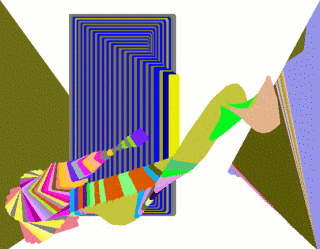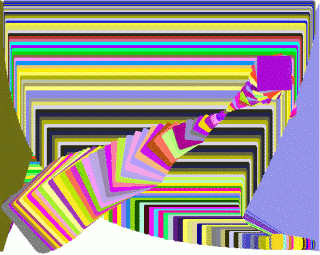Comparing
Weaver with
NomadS might
reveal a tension between works which are conceptually interesting and
works which are visually interesting.
Hopefully,
Quad
is somewhere in the middle of this aesthetic dichotomy..
As an exception, this work is not based on
the practical implementation of the basic parametrical space
system, which (on various levels) is fundamental to the other
early works (although this principle is still operative on a conceptual
level).
On one conceptual level, the work is based on a visual
interpretation/implementation of a
voltage
controlled oscillator -a fundamental piece of equipment found in
the
analogue studio at the
Institute for
Sonology (then in Utrecht), where the artist studied when a young
man.
Basically, a VCO produces a
sine-wave
-which varies in
frequency
according to the voltage level fed into it. however, the basic
amplitude
oscillates (in the theoretical model) between +1 and -1 which allows it
to be easily mapped into a dimension of any size (as happens when one
draws a circle -where the basic sine/cosine functions are mapped to a
specific radius).
Any changing variable has a minimum and a maximum value -so one can
easily link three oscillators together in a single group -such that
each oscillator has its minimum and maximum values determined by the
other two.
A rectangle can be constructed from any two points -each with an x and
a y coordinate -thus a total of 4 parameters is required. So it requires
a bit of 'fiddling" to create a group of oscillators which control the
movements of the two points that define a rectangle (this is something
that requires further working out within the context of the applet).
However, once this is established (more or less) -one can use the
colour value found at
the location of the point to control the relevant group of oscillators
(if one interprets the
colour in
terms of red, green, blue components this maps easily to three
oscillators -but one could include the
transparency
-in which case one would have four control parameters available).
Once a rectangle has been defined -it can be redefined as a diamond
shape -by bisecting the sides and connecting the points......
......Or one can interpret the original four parameters (which
determine the locations of the corners
of the rectangle) in completely different ways -as defining
the radius, rotation and central x,y position of a variable
square, for example -or even as determining the radius, rotation and
location of two connected lines.
Later, when sound is added, it will be interesting to see how the
oscillator system used for the sound will relate to the one used for
the image.
---------------------------------------------------------
To start Java Applets -click on the image
(No menu)
---------------------------------------------------------
--------------------------------------------------------

